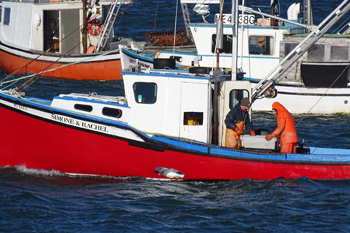Rotational Scallop System Underway
for 8th Season
by Sarah Craighead Dedmon

Scalloping off Lubec, Maine. Foreground, FV Simone & Rachel, Dustin Barker, left and Wayne Moores right. Background, Life’s Pleasures and Captain’s Lady. Chessie Crowe Gartmayer photo.
Not so many years ago, the Downeast tradition of enjoying scallops for the holidays seemed in peril. Though the winter fishery had experienced highs and lows before, after a record 1,729 metric tons in 1981 a gradual downward trajectory revealed itself in the landings data. By 2005, Atlantic scallop landings weighed in at an all-time low of 15 metric tons, statewide.
Then in 2012 the state enacted a rotational management system, which divides the coast into large zones and smaller areas that are opened and shut according to a calendar and the health of the resource, which is continually assessed throughout the season. Under the system, Downeast areas north of Penobscot Bay and south of Cobscook Bay open for one season, then close for two to allow spawning.
“I’ve been east of Cutler
fishing last week,
it’s a wreck”
– fisherman Ben Crocker,
Bucks Harbor, Maine
Dec. 2 marked the fourth opening of Zone 2’s second rotation, but stormy weather kept boats ashore for several days that week. Then, four days later the state closed Moosabec Reach, a small area adjoining Chandler Bay. Scallop landings data won’t be available until after the close of the season, but some Downeast fishermen are already feeling skeptical.
“I’ve been east of Cutler fishing last week, it’s a wreck,” said Ben Crocker Jr. of Bucks Harbor. “Scallops are old, meats are junk. We left more [on the bottom] three years ago than we can catch now.”
Since the beginning of the rotational management system, landings have been trending upward with one exception between 2017 and 2018, when they dropped by 30 percent. One drop does not a pattern make, but Mike Murphy of Machiasport said he believes the overall resource would be more plentiful if the rotations were closer together, or the fishermen were allowed to remove more scallops in each area, each year.
“We won’t get them all because, I mean, we never can anyway. That’s the fishermen’s best quality — his inefficiency,” said Murphy, laughing. “We don’t fish around the clock, we can’t see what’s on bottom, we’re just never going to catch them all.”
After closing the fishery to new licenses for almost 10 years, in 2018 the Maine Department of Marine Resources reopened it with a license lottery. The state uses a 3:2 exit ratio for drag licenses, meaning that for every three drag licenses that are retired, two may be issued. The exit ratio for scallop divers is 1:1. In 2018, four drag licenses were awarded through the lottery, and this year there were six lucky winners for dragging and four dive licenses.
“Early indicators are
that it might be down
from last time, but
each rotation has its
pluses and minuses.”
– Kristan Porter,
Cutler, Maine
The climbing license numbers reflect climbing enthusiasm for the once-gutted fishery. DMR data shows 168 active commercial scallop licenses in 2009, when market prices averaged $7.41 per pound, compared with 445 in 2015 when scallops brought $12.71 per pound. In 2019 there are 479 licensed draggers.
Fisherman Kristan Porter of Cutler said he has been out dragging as much as he could, but between the storms and hauling in traps there have been some missed days. He notes that this season’s landings aren’t off to a banner start, but said he isn’t worried.
“For here, it’s a little too early to tell. Early indicators are that it might be down from last time,” said Porter, “but each rotation has its pluses and minuses.”
Because the zone management system was designed to “sunset” after ten years, the DMR will begin a process of reevaluation prior to the 2021-22. DMR spokesperson Jeff Nicholes said at that time the state will collect industry feedback, and consider whether to extend the rotational plan, or to change to another approach such as limited access, or targeted closures. “Any new management measures will then need to be implemented through rulemaking,” said Nichols.
